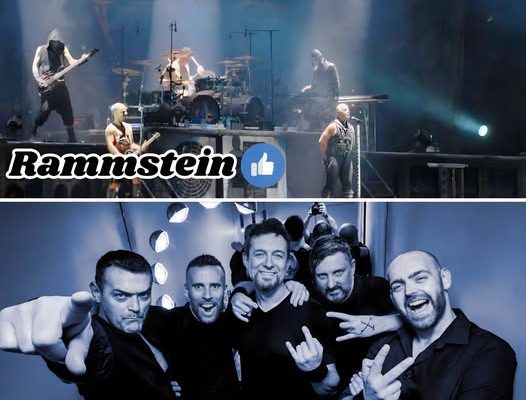Rammstein’s monumental industrial metal sound has long been a force of nature within the heavy music landscape, commanding attention with its powerful riffs, thunderous rhythms, and theatrical intensity. Their music embodies a seismic collision of harsh machinery-like percussion, grinding guitars, and Till Lindemann’s deep, commanding vocals, all wrapped in an aesthetic that feels equal parts dystopian industrial wasteland and explosive pyrotechnic spectacle. This is music that doesn’t just play loud; it reverberates through your entire body, shaking the ground beneath you and forging a connection to raw power and primal emotion. Their influence is unmistakable, defining industrial metal with an uncompromising authenticity that has inspired countless acts and left an indelible mark on heavy music culture worldwide.
On the other side of this sonic battleground stands Pitchshifter, a band that’s never been content to be boxed in by any single genre. Emerging from the UK’s underground scene in the early 90s, Pitchshifter carved out a unique niche by blending electronic elements, hip-hop beats, nu-metal aggression, and industrial textures into a fiercely innovative hybrid. Their sound pulses with a kinetic energy born from a fusion of synthesized atmospheres and distorted guitars, layered with fragmented, rhythmic vocals that convey urgency and defiance. They embrace experimentation, their music teetering on the edge of chaos and precision, creating an adrenaline rush that’s both cerebral and physical. This blend of styles reflects a restless, boundary-pushing spirit, one that challenges listeners to rethink what heavy music can be while maintaining a visceral intensity that demands movement and confrontation.
Imagining a grand sound clash between Rammstein’s monumental industrial metal and Pitchshifter’s daring hybrid of electronic energy and nu-metal edge ignites a thrilling sonic narrative. It’s a collision not merely of styles but of ideologies and artistic identities. Rammstein’s music embodies the brute force of industrial landscapes, machinery’s relentless pulse, and an almost ritualistic dedication to grandeur and spectacle. Pitchshifter, conversely, thrives on innovation, channeling urban alienation and technological anxieties through a constantly evolving amalgam of sounds that includes glitch, drum-and-bass rhythms, and hip-hop influenced vocal delivery.
If these two forces were to converge in a single soundscape, the result would be a monumental sonic forge, hammering out something simultaneously massive and intricate. Imagine the grinding, mechanical chug of Rammstein’s guitars and percussion providing a foundation—a relentless, pounding industrial heart beating with enormous weight and intensity. Over that, the electronic layers typical of Pitchshifter would weave complex, shimmering textures, oscillating synth patterns, and fractured beats that disrupt the monolithic pulse with kinetic unpredictability. This layered approach would create a dynamic tension, a push and pull between the raw, elemental power of industrial metal and the fractured, digitalized chaos of electronic experimentation.
The vocals would offer an equally compelling dialogue. Till Lindemann’s deep, guttural German delivery is iconic for its commanding presence and chilling theatricality, evoking images of cold, mechanized strength and enigmatic ritual. Against this, Pitchshifter’s vocal style, often featuring rapid-fire, almost spoken-word verses, layered with shouted hooks and electronic manipulation, introduces a frantic, contemporary edge. Their vocal interplay could unfold like a dramatic conversation between two contrasting personas—one grounded in the primal and mythic, the other in the urban and postmodern. The languages themselves—German and English—would add an additional texture to the clash, highlighting cultural and linguistic contrasts within the shared realm of heavy music.
Musically, the fusion would explore extremes of both heaviness and intricacy. Rammstein’s trademark chugging riffs—heavy, palm-muted, and precise—could anchor songs, providing a solid and crushing groove. This would be amplified by their relentless, industrial percussion, often mimicking the sound of heavy machinery, welding sparks, and factory floors. Meanwhile, Pitchshifter’s rhythmic experiments would introduce syncopated drum patterns, sampled beats, and glitchy electronic effects, breaking up the steady march of industrial machinery with bursts of unpredictability and rhythmic complexity. The dynamic range would be immense, with moments of colossal sonic weight punctuated by sections where digital textures and bass-heavy electronic pulses create almost danceable, head-nodding grooves.
Production-wise, the collaboration would be an exercise in balancing massive, wall-of-sound elements with clarity and space. Rammstein’s production style is dense yet polished, ensuring every riff and percussion hit cuts through the mix with brutal clarity. Pitchshifter’s approach leans into layering and textural diversity, using electronic production techniques to sculpt soundscapes that are as much about atmosphere as aggression. Combining these approaches would mean crafting a sound that is simultaneously huge and spacious—monolithic riffs towering above, yet with room for intricate electronic flourishes and rhythmic surprises to breathe and engage listeners at a micro-level.
Lyrically, the clash could explore a wide spectrum of themes resonant with both bands’ histories but reinterpreted through the lens of their combined sonic identities. Rammstein’s lyrics often grapple with dark aspects of human nature, power structures, and taboo subjects, conveyed with a theatrical and sometimes ironic edge. Pitchshifter’s lyricism tends to focus on social alienation, technological paranoia, and political unrest, delivered with an urgency and directness reflecting their roots in punk and electronic subcultures. Together, the themes could merge into a narrative exploring the dehumanizing effects of technology and industrial society, the tension between control and chaos, and the struggle for identity in a mechanized, digitalized world.
The live manifestation of such a sound clash would be a spectacle of contrasts and synergy. Rammstein’s legendary live shows are known for their pyrotechnics, dramatic staging, and larger-than-life personas, transforming concerts into immersive theatrical experiences. Pitchshifter’s live presence, while less grandiose in scale, is charged with raw energy and precision, often incorporating multimedia visuals and electronic elements that complement their hybrid sound. Combining these elements on stage could create a performance that is both visually and sonically overwhelming, blending fire and steel with flashing lights and electronic wizardry. The audience would be enveloped in a sensory storm, where pounding industrial beats meet swirling digital chaos, driving an intense collective catharsis.
The historical and cultural significance of a meeting between Rammstein and Pitchshifter would also be profound. Both bands emerged from distinct cultural milieus—Rammstein from post-reunification Germany, navigating complex national and industrial histories, and Pitchshifter from the UK’s electronic and metal underground, reflecting the urban decay and technological flux of the late 20th century. Their collaboration would represent a bridging of cultural perspectives and musical traditions, highlighting how heavy music can transcend borders and languages to speak to universal anxieties and energies.
From a fan perspective, this fusion would likely draw a diverse audience, uniting devotees of pure industrial metal with followers of electronic and nu-metal hybrids. It could serve as a gateway for listeners to explore genres outside their usual preferences, broadening the horizons of heavy music fandom. The crossover appeal would be immense, appealing to metalheads who appreciate the crushing power and dark theatrics of Rammstein, and to electronic and alternative music fans attracted to Pitchshifter’s innovative sound design and rhythmic experimentation.
Moreover, such a sound clash would open exciting new creative possibilities beyond traditional genre boundaries. It would challenge the notion that heavy music must conform to rigid stylistic parameters and instead celebrate hybridity, complexity, and innovation. The collaboration could inspire new approaches to songwriting, production, and performance, encouraging artists across genres to experiment with blending organic and synthetic elements, structured heaviness and rhythmic fluidity, and theatrical intensity with electronic abstraction.
In essence, the grand sound clash between Rammstein’s monumental industrial metal and Pitchshifter’s daring blend of electronic energy and nu-metal edge would be a powerful testament to the evolving nature of heavy music. It would honor the roots of industrial metal while pushing forward into uncharted sonic territory, creating a thrilling, multifaceted experience that resonates on both a physical and intellectual level. The fusion would not just be a meeting of sounds but a conversation across cultures, histories, and artistic visions, forging a new path where the machine’s relentless heartbeat and the electric pulse of innovation collide to create something truly monumental.
Such a collaboration, whether hypothetical or actualized, embodies the spirit of artistic evolution—where tradition and experimentation coexist, and where the boundaries of genre dissolve to reveal new landscapes of sound. It invites listeners to immerse themselves in a world where raw power meets intricate design, where the primal and the futuristic intertwine, and where the clash of monumental and daring styles sparks a creative explosion that echoes far beyond the stage or studio. This grand sound clash, then, is not merely a fusion of two bands or genres, but a celebration of heavy music’s potential to evolve, challenge, and captivate anew.



